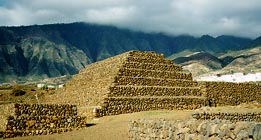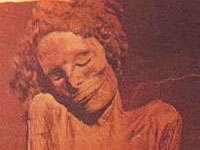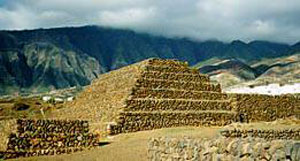
extracted from "History
of White Race - Chapter 6"
2008
Off the coast of West Africa lie the Canary Islands - this region
became home to a mysterious group in antiquity who became known as
the Guanches.
While it is unknown for sure how they arrived on the islands, what is
known is that they shared a number of cultural characteristics with
the ancient Egyptians and that their building style appears to have
been replicated in South and Central America.
Like the Celtic Tocharians, the finest evidence of what
the original Guanche looked like, is in the fortuitous existence of
original Guanche mummies, which are on public display in that island
group's national museum.
The corpses on display are estimated to be
between 600 and 1000 years old.
Above: Guanche
mummies, with red hair and other Nordic features - the original
inhabitants of the Canary Islands.
They are likely to be the
original Cro-Magnons.
An examination of one of
the mummies' bodies showed incisions that virtually matched those
found in Egyptian mummies, although the string used by the Guanche
embalmers to close the wounds was much coarser than would have been
used by the Egyptian experts.
The Guanches also possessed the art of writing, although this has not
yet been the subject of any major study.
THE GUANCHE PYRAMIDS ON THE CANARY ISLANDS
However, the most stunning link between the Guanches and the Egyptians
comes in the form of pyramids - the Guanches built several small
step pyramids on the islands, using the same model as those found in
ancient Egypt and in Mesopotamia.
The pyramids have an east-west
alignment which also indicates that they probably had a religious
purpose, associated with the rise and setting of the sun.
Carefully built stairways on the west side of each pyramid lead up to
the summit, which in each case has a flat platform covered with
gravel, possibly used for religious or ceremonial purposes.
Above left: One
of the Pyramids of Guimar, Canary Islands.
Right: A Mayan pyramid in Central America (Chichen Itza).
The
resemblance is unmistakable.
Return
to Construcciones Piramidales en el Mundo
GUANCHE TYPE PYRAMIDS FOUND IN MEXICO
The famous explorer, Thor Heyerdahl, who "rediscovered" the
pyramids on the Canary Islands and who set up an academic body to
study the phenomena, argued that the pyramids may be remains from
explorers who sailed the Atlantic in ancient times, and who may have
possibly forged a link with the pre-Columbian civilizations of the
Americas.
As the original inhabitants of the Canary Islands were fair-haired and
bearded, it was possible, Heyerdahl suggested, that long
before the 15th Century, people of the same stock as those who
settled the Canary Islands, also sailed the same route along the
Canary Current that took
Christopher Columbus to the Americas.
This theory formed the basis of Heyerdahl's famous "RA"
expeditions in which he showed that is was possible to cross the
Atlantic in an Egyptian reed boat.
In fact Columbus' starting off point was the Canary Islands,
where he obtained supplies and water on Gomera, the island next to
Tenerife. The Guanches on Tenerife in 1492 did not permit Columbus
to land on their island - they were not impressed by the physical
appearance of the bearded Europeans, who looked like the Guanches
themselves.
When Columbus and the Europeans who followed in his wake landed in the
Americas, they were welcomed and initially worshiped as gods, since
the beardless Indians they encountered believed that the spanish
belonged to the same people as the legendary founders of their
civilization, bearded men from across the Atlantic Ocean.
According to the Aztec and Olmec (Central American Amerind) legends,
their god, Quetzalcoatl, had Nordic features (eyes and hair color)
and a beard. This god came from over the sea and taught the Amerinds
how to raise corn and build structures.
There is indeed a marked similarity between the step pyramids to be
found on the Canary Islands and those to be found in Central and
South America, strongly suggesting yet another great lost migration,
this time to Central and South America, perhaps a thousand years or
more before Columbus.
The existence of the red-haired Guanches on the Canary Islands,
combined with the red-haired pre-Columbus mummies found in South
America and the marked similarity in pyramid building styles,
indicate that an over the atlantic people probably used the Canaries
Current to cross the Atlantic, most likely between 2000 and 500 BC.
Columbus himself used the Canaries Current, setting out from the
Canary Islands on his first crossing of the Atlantic in 1492 AD.
There is also clear evidence from the Mexican side of the Atlantic
Ocean that blond-haired people reached that part of the world long
before the spanish explorations of the late 1490s.
Below is a pre-Columbian wall painting which can be found in the
Temple of the Warriors, Chichen Itza, on the east coast of Mexico.
The first depicts prisoners after their capture by the dark-skinned
natives, and the second, shows a man with long blond hair being
sacrificed.
It is worthwhile to remember that these paintings date
from before
Christopher Columbus sailed the Atlantic in 1492.
THE DISAPPEARANCE OF THE GUANCHES
Guanche artifacts, such as cave murals, tombs, stone and mortar walls,
broken pottery and other everyday items are abundant on the island.
Similar artifacts have been found on the African continent itself -
notably in Morocco, indicating that at some stage the Guanches
crossed the sea to Africa.
There they started mixing with other racial types on the African
continent itself. This process is very likely to be the cause of
some flashes of blond hair and light colored eyes still to be found
amongst the Berber population of north west Africa to this day.
The pyramids and other structures on the islands seem to have been
constructed by an advanced people - certainly by the time of the
Spanish invasion, the Guanches had lost much of their civilized
apparel, and Spanish accounts have it that they were attacked by
naked tribesmen, who sometimes inflicted serious military defeats
upon the invading Spaniards. It was only in 1496 that the Spaniards
finally defeated the last of the Guanches.
The arrival of the Spaniards in the mid 14th Century saw the remaining Guanches absorbed into the new settler population. The blond,
blue-eyed, tall stock has been preserved in part, and can still be
seen today in many individuals on the island.
Culturally speaking,
the Guanche civilization was completely absorbed by the imported
continental European culture, so that the Canary Islands remains
Spanish territory to this day.

Archaeologists and authorities scoffed when a local newspaper
published an article claiming to have discovered mysterious
step-pyramids on the island of Tenerife.
Just more agricultural
stone terraces they said, such as are common throughout the
Canaries.
But Thor Heyerdahl thought differently. Dr. Heyerdahl,
who has done extensive research on the
pyramids of Tucume in Peru,
was intrigued by photos of the site, and on visiting the
valley of Guimar to see for himself, he was no longer in any
doubt. These were neither terraces nor random piles of stone cleared
by the Spaniards, as some had tried to explain them away.
They were
painstakingly built step-pyramids, constructed according to similar
principles as those of Mexico, Peru, and ancient Mesopotamia.
The Evidence
Far from being piles of unworked rubble, every stone was turned with
its flat side out and placed together by stone masons. With slopes
of the volcano Mt. Teide at their back and facing the
Atlantic, the edifices are precisely aligned according to the sunset
on the summer solstice, as are other sacred structures in different
parts of the world.
 Carefully built
stairways on the west side of each pyramid lead up to the
summit, which is not a pile of stones, but a perfectly flat
platform covered with gravel, as though for ceremonial
performances and/or sun worship. Carefully built
stairways on the west side of each pyramid lead up to the
summit, which is not a pile of stones, but a perfectly flat
platform covered with gravel, as though for ceremonial
performances and/or sun worship.
The stones were not weather-worn, rounded boulders, such as
farmers had found in the fields, but sharp fragments of lava,
and some of the corner stones had been trimmed.
Archaeologists from the
University of La Laguna were contracted to do test
excavations of a ceremonial platform between two of the pyramids.
As
predicted by Dr. Heyerdahl, they found that rather than being
a random pile of stones as they had expected, it was built of
blocks, gravel and earth. The skeptics had to admit that this was
definitely some kind of ceremonial architecture.
Yet some still
refused to admit that such impressive structures could have been
built by the Guanche, the original inhabitants of
Tenerife, and suggested that they might have been constructed by
the early Christian conquistadores (sic) as a time measuring
device to know when to celebrate the Catholic festivities of St.
John.
What is the Significance of the Pyramids?
Following Dr. Heyerdahl's express wishes, no theory is forced
on the visitors to Guimar. In fact the symbol of the exhibit is a
question mark, asking each person to make up his own mind.
Yet certainly, the evidence leads Heyerdahl and others involved
in the project to believe that these pyramids may be remains from
pre-European voyagers who sailed the Atlantic in ancient times,
and may have possibly forged a link with the
pre-Columbian civilizations of the Americas.
Among the original inhabitants of the Canaries many were fair-haired
and bearded, and probably related to the Berbers who inhabited the
coastal areas of North Africa before the Arab conquest. Is it
possible that long before the 15th century, people of the same stock
as those who settled the Canary Islands also sailed the same route
along the Canary Current that Columbus took to the Americas?
Columbus' starting off point was the Canaries, where his ships got
supplies and water on Gomera, the island next to Tenerife.
The Guanches
on Tenerife in 1492 did not permit Columbus or any other Europeans to
land on their island. They were not impressed by the physical
appearance of the bearded Europeans, who looked like the
Guanches themselves.
But when Columbus and the Europeans who
followed in his wake landed in the New World they were welcomed and
initially worshipped as gods, since the beardless Indians they
encountered believed that the Spanish belonged to the same people as
the legendary founders of their civilization, bearded
men from across the Atlantic Ocean.
|






 Carefully built
stairways on the west side of each pyramid lead up to the
summit, which is not a pile of stones, but a perfectly flat
platform covered with gravel, as though for ceremonial
performances and/or sun worship.
Carefully built
stairways on the west side of each pyramid lead up to the
summit, which is not a pile of stones, but a perfectly flat
platform covered with gravel, as though for ceremonial
performances and/or sun worship.